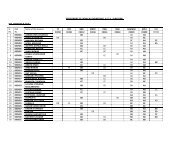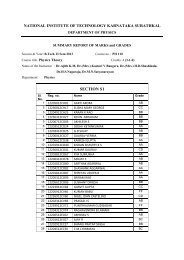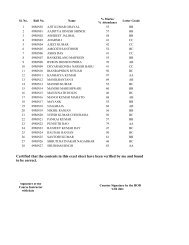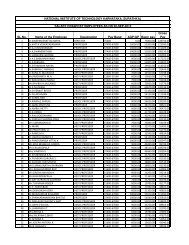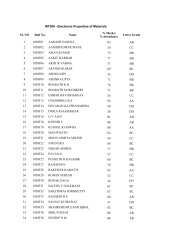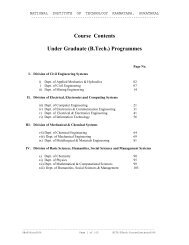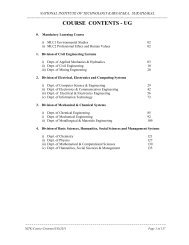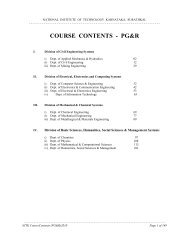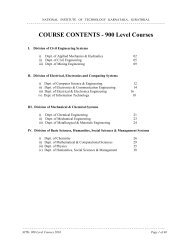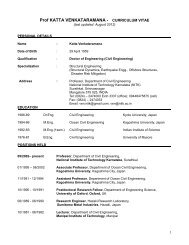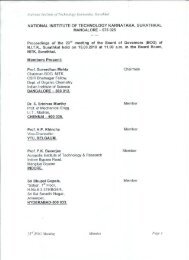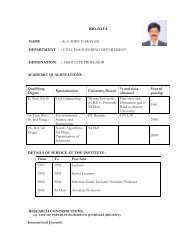course contents - ug - National Institute of Technology Karnataka
course contents - ug - National Institute of Technology Karnataka
course contents - ug - National Institute of Technology Karnataka
You also want an ePaper? Increase the reach of your titles
YUMPU automatically turns print PDFs into web optimized ePapers that Google loves.
NATIONAL INSTITUTE OF TECHNOLOGY KARNATAKA, SURATHAKAL<br />
------------------------------------------------------------------------------------------------------------------<br />
EE373 ELECTRIC POWER STATIONS (3-1-0)<br />
Choice <strong>of</strong> site for power plants (hydro, thermal, nuclear power). Thermal power plant: 4 general layout, Air<br />
and flue-gas circuit, Fuel and ash handling circuit, Cooling water circuit, Steam and feed water circuit.<br />
Essential components associated with this circuit. Nuclear power plant: General layout <strong>of</strong> nuclear reactor,<br />
materials their requirements <strong>of</strong> heat exchange, moderators, coolants, control rods. Classification <strong>of</strong><br />
reactors, Fuels, Radioactive waste handling system. Hydro power plant: Site selection for hydro power<br />
plants: reservoir capacity from mass curve and hydrographs. Power availability. General layout, Type <strong>of</strong><br />
hydropower plants, Characteristics <strong>of</strong> turbines, Specific speed, Speed governors. Gas turbines;<br />
Unconventional power generation. Electrical equipment in generating stations: General layout, Excitation<br />
systems and voltage regulation. Substation layout, Components <strong>of</strong> substation. Bus-bar arrangements,<br />
Current-limiting reactors and their location. Reactance <strong>of</strong> current limiting reactors. Station activities <strong>of</strong><br />
operators, Maintenance engineer, Safety and coordination. Load forecasting and sharing: Load curve and<br />
load duration curves, Load factor, Diversity factor, Plant factor and plant use factor, Demand factor,<br />
Selection <strong>of</strong> generating units. Load sharing between base and peak load stations. Operational schedule.<br />
M. V. Deshpande, Electrical Power Stations.<br />
Tata Electric Co., Operator Training Manual.<br />
Other Handbooks and O&M Manuals <strong>of</strong> relevance.<br />
EE374 ELECTRIC ENERGY SYSTEMS (3-0-0)<br />
Conventional and Non Conventional Energy Sources and Systems, Generation, 3 Transmission and<br />
Distribution Schemes, Energy Conservation Systems, Energy Efficient Equipment and Controllers,<br />
Energy Audit.<br />
Olle I. Elgerd , Electric Energy System Theory: An Introduction, TMH, 1982.<br />
I.J. Nagrath, D.P. Kothari, Power System Engineering, TMH.<br />
EE376 ADVANCED CONTROL SYSTEMS (3-0-0)<br />
Introduction, review <strong>of</strong> state space approach to modeling dynamic system Introduction 3 to discrete time<br />
control system, Signal processing in digital control, models <strong>of</strong> digital control devices and systems, z-plane<br />
analysis <strong>of</strong> discrete time control system, Transient response analysis, design specifications and<br />
performance indices, design <strong>of</strong> digital control algorithms, state variable analysis <strong>of</strong> digital control<br />
systems, Pole placement design and state observers, Linear quadratic optimal control<br />
K. Ogata, Discrete Time Control Systems, 2 nd Edition, Pearson Education.<br />
M. Gopal, Digital Control and State Variable Methods, TMH.<br />
EE377 MODELING AND SIMULATION TECHNIQUES FOR DYNAMIC SYSTEMS (3-1-0)<br />
4<br />
Introduction to system dynamics, Transfer function approach to modeling dynamic systems, Modeling <strong>of</strong><br />
electrical and electromechanical systems, Mechanical systems, State-space approach to modeling<br />
dynamic systems, Bond graphs method, Transient analysis <strong>of</strong> dynamic systems, Frequency domain<br />
analysis <strong>of</strong> dynamic systems, Numerical techniques applied to dynamic systems.<br />
MathWorks Inc., MATLAB®/ SIMULINK Reference/User Manuals, MathWorks Inc.<br />
K. Ogata, System Dynamics, 4 th Edition, Pearson Education.<br />
K. Ogata, Discrete Time Control Systems, 2 nd Edition, Pearson Education.<br />
EE378 SHELL SCRIPTING WITH BASH (3-1-0)<br />
The Linux environment: Files and filesystems, directories, inodes and links, pipe and 4 socket files, device<br />
files. Operating the shell, Bash keywords, Command basics, Command-line editing; Files, users and shell<br />
customization, working with files. Script basics, Creating a well-behaved script, Basic redirection,<br />
Standard output, error and input, Built-in versus Linux commands.<br />
Variables: Basics and attributes, Bash pre-defined variables, Expressions, Arithmetic and logical<br />
expressions, Relational, bitwise and self-referential operations, substitutions. Compound commands,<br />
Deb<strong>ug</strong>ging and revision control, Shell archives, Parameters and subshells, Job control and signals. Text<br />
---------------------------------------------------------------------<br />
NITK-Course Contents(UG)2010 Page 63 <strong>of</strong> 134



